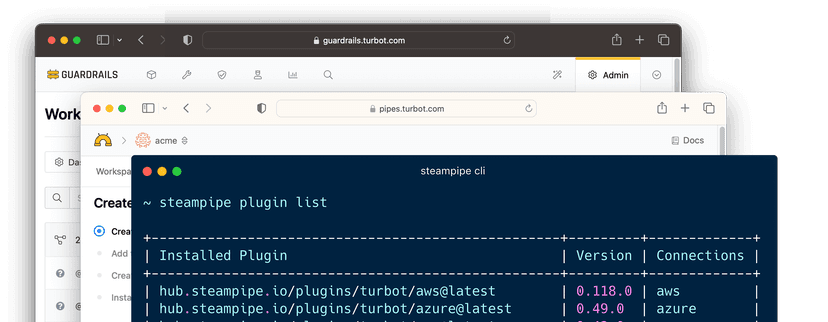Changelog
Subscribe to Turbot changelog via RSS or join #changelog on our Slack community to stay updated on everything we ship.

azure-redis v5.0.0 is now available
guardrailsMods
Pipes SDK Go v0.16.0
pipes
Chat with your cloud
pipes
Pipes SDK Go v0.15.0
pipes
aws-s3table v5.0.0 is now available
guardrailsMods
Pipes SDK Go v0.14.0
pipes
Pipes SDK Go v0.13.0
pipes
GitLab integration
pipes
github v5.0.0 is now available
guardrailsMods
Okta plugin updates
pipes
Powerpipe Mods - v1.0.0 release
powerpipe
Steampipe CLI v1.0.0
steampipe
Powerpipe CLI v1.0.0
powerpipe
Flowpipe mods - v1.0.0 release
flowpipe
Flowpipe CLI v1.0.0
flowpipe
Steampipe Plugins - v1.0.0 release
steampipe
gcp-dataplex v5.0.0 is now available
guardrailsMods
aws-support v5.0.0 is now available
guardrailsMods
gcp-vertexai v5.0.0 is now available
guardrailsMods
Pipes SDK Go v0.10.0
pipes
GCP integration
pipes
Azure integration
pipes
AWS integration
pipes
GitHub integration
pipes
kubernetes v5.0.1 is now available
guardrailsMods
osquery v5.0.0 is now available
guardrailsMods
kubernetes v5.0.0 is now available
guardrailsMods
aws-cisv3-0 v5.0.0 is now available
guardrailsMods
gcp-cisv2-0 v5.0.0 is now available
guardrailsMods
aws-cisv2-0 v5.0.0 is now available
guardrailsMods
Powerpipe Mods - 52 new mods
powerpipe
servicenow v5.0.0 is now available
guardrailsMods
aws-kendra v5.0.0 is now available
guardrailsMods
aws-bedrock v5.0.0 is now available
guardrailsMods
Pipes Zapier app
pipes
Turbot Guardrails CLI v1.29.0
guardrailsCLI
Turbot Guardrails Enterprise (TE) v5.40.11
guardrailsTE
Turbot Guardrails Enterprise (TE) v5.40.8
guardrailsTE
Turbot Guardrails Enterprise (TE) v5.40.10
guardrailsTE
Turbot Guardrails Enterprise (TE) v5.40.7
guardrailsTE
Turbot Guardrails Enterprise (TE) v5.40.6
guardrailsTE
Turbot Guardrails Enterprise (TE) v5.40.5
guardrailsTE
Turbot Guardrails Enterprise (TE) v5.40.4
guardrailsTE
Turbot Guardrails Enterprise (TE) v5.40.3
guardrailsTE
Turbot Guardrails Enterprise (TE) v5.40.2
guardrailsTE
Turbot Guardrails Enterprise (TE) v5.40.1
guardrailsTE
Turbot Guardrails Enterprise (TE) v5.40.0
guardrailsTE
Turbot Guardrails Enterprise (TE) v5.39.12
guardrailsTE
Turbot Guardrails Enterprise (TE) v5.39.11
guardrailsTE
Turbot Guardrails Enterprise (TE) v5.39.9
guardrailsTE
Turbot Guardrails CLI v1.28.6
guardrailsCLI
Turbot Guardrails Enterprise (TE) v5.39.8
guardrailsTE
Turbot Guardrails Enterprise (TE) v5.39.7
guardrailsTE
Turbot Guardrails Enterprise (TE) v5.39.6
guardrailsTE
Turbot Guardrails Enterprise (TE) v5.39.5
guardrailsTE
Turbot Guardrails Enterprise (TE) v5.39.4
guardrailsTE
Turbot Guardrails Enterprise (TE) v5.39.3
guardrailsTE
Turbot Guardrails Enterprise (TE) v5.39.2
guardrailsTE
Turbot Guardrails Enterprise (TE) v5.39.1
guardrailsTE
Turbot Guardrails Enterprise (TE) v5.39.0
guardrailsTE
Turbot Guardrails CLI v1.28.5
guardrailsCLI
Turbot Guardrails CLI v1.28.4
guardrailsCLI
Turbot Guardrails CLI v1.28.3
guardrailsCLI
Turbot Guardrails CLI v1.28.2
guardrailsCLI
Turbot Guardrails CLI v1.28.1
guardrailsCLI
Turbot Guardrails CLI v1.28.0
guardrailsCLI
Turbot Guardrails CLI v1.27.0
guardrailsCLI
Turbot Guardrails CLI v1.26.0
guardrailsCLI
Turbot Guardrails CLI v1.25.0
guardrailsCLI
Turbot Guardrails CLI v1.24.3
guardrailsCLI
Turbot Guardrails CLI v1.24.2
guardrailsCLI
Turbot Guardrails CLI v1.24.1
guardrailsCLI
Turbot Guardrails CLI v1.24.0
guardrailsCLI
Turbot Guardrails CLI v1.23.0
guardrailsCLI
Turbot Guardrails CLI v1.22.0
guardrailsCLI
Turbot Guardrails CLI v1.21.0
guardrailsCLI
Turbot Guardrails CLI v1.20.1
guardrailsCLI
Turbot Guardrails CLI v1.20.0
guardrailsCLI
Turbot Guardrails CLI v1.19.3
guardrailsCLI
Turbot Guardrails CLI v1.19.2
guardrailsCLI
Turbot Guardrails CLI v1.19.1
guardrailsCLI
Turbot Guardrails CLI v1.19.0
guardrailsCLI
Turbot Guardrails CLI v1.18.1
guardrailsCLI
Turbot Guardrails CLI v1.18.0
guardrailsCLI
Turbot Guardrails CLI v1.17.3
guardrailsCLI
Turbot Guardrails CLI v1.17.2
guardrailsCLI
Turbot Guardrails CLI v1.17.1
guardrailsCLI
Turbot Guardrails CLI v1.17.0
guardrailsCLI
Turbot Guardrails CLI v1.16.0
guardrailsCLI
Turbot Guardrails CLI v1.15.1
guardrailsCLI
Turbot Guardrails CLI v1.15.0
guardrailsCLI
Turbot Guardrails CLI v1.14.0
guardrailsCLI
Turbot Guardrails CLI v1.13.0
guardrailsCLI
Turbot Guardrails CLI v1.12.0
guardrailsCLI
Turbot Guardrails CLI v1.11.0
guardrailsCLI
Turbot Guardrails CLI v1.10.0
guardrailsCLI
Turbot Guardrails CLI v1.9.0
guardrailsCLI
Turbot Guardrails CLI v1.8.0
guardrailsCLI
Turbot Guardrails CLI v1.7.0
guardrailsCLI
Turbot Guardrails CLI v1.6.0
guardrailsCLI
Turbot Guardrails CLI v1.5.1
guardrailsCLI
Turbot Guardrails CLI v1.5.0
guardrailsCLI
Turbot Guardrails CLI v1.4.1
guardrailsCLI
Turbot Guardrails CLI v1.4.0
guardrailsCLI
Turbot Guardrails CLI v1.3.1
guardrailsCLI
Turbot Guardrails CLI v1.3.0
guardrailsCLI
Turbot Guardrails CLI v1.2.1
guardrailsCLI
Turbot Guardrails CLI v1.2.0
guardrailsCLI
Turbot Guardrails CLI v1.1.1
guardrailsCLI
Turbot Guardrails CLI v1.1.0
guardrailsCLI
Turbot Guardrails CLI v1.0.4
guardrailsCLI
Turbot Guardrails CLI v1.0.3
guardrailsCLI
Turbot Guardrails CLI v1.0.2
guardrailsCLI
Turbot Guardrails CLI v1.0.1
guardrailsCLI
Turbot Guardrails CLI v1.0.0
guardrailsCLI